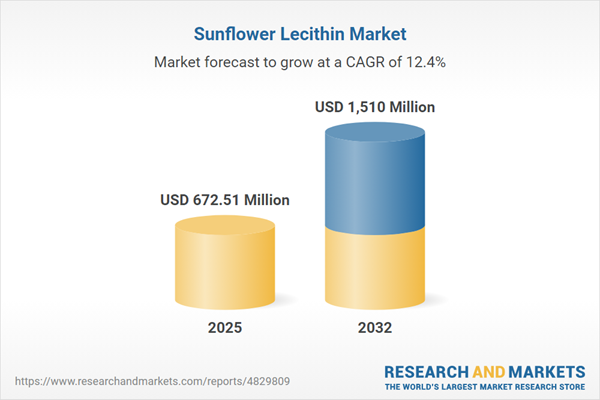Speak directly to the analyst to clarify any post sales queries you may have.
Senior executives operating in the sunflower lecithin market face crucial decisions around regulatory compliance, procurement innovation, and technological adoption. Effective leadership in this sector means proactively managing risk while enhancing supply chain agility in response to rapidly changing market demands.
Market Snapshot: Sunflower Lecithin Market Growth Outlook
The sunflower lecithin market is poised for significant expansion, projected to increase from USD 597.06 million in 2024 to USD 672.51 million by 2025, and reach a global value of USD 1.51 billion in 2032, equating to a steady CAGR of 12.36%. Growth is underpinned by robust demand across the food, pharmaceutical, and personal care industries, each seeking alternative emulsifiers and stable, traceable supply chains. Digital tracking tools and advancements in extraction methods are supporting greater reliability and efficiency, while shifting regulatory standards are prompting manufacturers to enhance compliance strategies and fortify their risk management approaches.
Scope & Segmentation in the Sunflower Lecithin Market
Senior leaders benefit from a comprehensive understanding of procurement, compliance, and operational criteria influencing the sunflower lecithin landscape. Detailed market segmentation highlights areas of opportunity and addresses procurement challenges faced by enterprises navigating evolving customer and regulatory requirements.
- Form: Liquid, powder, high-purity, standard, spray-dried, and vacuum-dried formats meet specific technical and performance needs in various commercial and industrial applications.
- Nature: Conventional and organic options support diverse sourcing strategies, enabling alignment with sustainability goals and certifications relevant to consumer and regulatory expectations.
- Grade: Cosmetic, food, pharmaceutical, and industrial standards guide quality assurance and application-specific compliance, facilitating entry into regulated industries.
- Application: Utilization extends to bakery, dairy, confectionery, functional foods, animal feed, pharmaceuticals, cosmetics, and personal care, offering flexibility for innovation and market responsiveness.
- Distribution Channel: Direct sales, offline retail, proprietary e-commerce, and third-party platforms enhance market access, allowing buyers to optimize sourcing strategies globally and locally.
- Geography: Regional markets across the Americas, Europe, Middle East, Africa, and Asia-Pacific experience distinct supply dynamics and compliance requirements, presenting unique pathways for growth and differentiation.
- Key Players: Organizations such as Archer Daniels Midland Company, Cargill, Bunge Limited, and Lecico GmbH & Co. KG serve as industry benchmarks, driving standards and reliability expectations throughout the value chain.
The adoption of advanced technologies, from membrane separation and enzymatic extraction to blockchain-driven traceability, is contributing to consistent product quality and improved audit processes. In regional markets, the Americas emphasize supply continuity, Europe focuses on regulatory adaptation, and Asia-Pacific leverages technology to build export competitiveness and address evolving global needs.
Key Takeaways for Senior Decision-Makers
- Clean-label, allergen-free sunflower lecithin is increasingly favored by buyers prioritizing transparency and accountability, essential for trust in tightly regulated industries.
- Innovative emulsification techniques empower manufacturers to adapt quickly to regulatory changes and varied customer specifications, strengthening market resilience.
- Embracing digital procurement tools and automated supply chain platforms allows businesses to react swiftly to market disruptions and shifting demand profiles.
- Strategic partnerships with established suppliers streamline audit processes and simplify entry into regions where sustainability and regulatory demands are high.
- Investing in integrated procurement and compliance systems reduces administrative burdens while heightening organizational accountability—a pivotal focus for procurement leaders.
Tariff Impact: Navigating the 2025 U.S. Tariffs
- Impending U.S. tariffs are accelerating efforts to diversify sourcing and foster domestic production, thereby minimizing exposure to external vulnerabilities.
- Manufacturers are proactively adjusting product formulations and exploring substitute ingredients as a means to safeguard output amid changing trade conditions.
- Scenario-based planning, deployment of predictive analytics, and adaptive logistics strategies are essential for sustaining operational continuity and ensuring compliance, as international trade frameworks evolve.
Methodology & Data Sources
This report draws from peer-reviewed studies, regulatory analyses, targeted industry polling, and senior executive interviews. Scenario modeling informs procurement planning and enhances risk-awareness throughout the sunflower lecithin supply chain.
Why This Report Matters
- Equips leaders with actionable guidance for fortifying digital supply chains, enhancing traceability, and optimizing for ESG compliance amid a dynamic regulatory environment.
- Supports the development and realignment of sourcing and compliance frameworks, enabling executive teams to stay ahead of global trade and regulatory trends.
- Provides proven recommendations for managing distribution networks and cultivating supplier ecosystems to ensure operational resilience and sustained competitive advantage.
Conclusion
Focusing on innovation, robust compliance, and responsive sourcing empowers senior leaders to strengthen operational resilience and maintain strategic advantage as sunflower lecithin markets evolve worldwide.
Additional Product Information:
- Purchase of this report includes 1 year online access with quarterly updates.
- This report can be updated on request. Please contact our Customer Experience team using the Ask a Question widget on our website.
Table of Contents
3. Executive Summary
4. Market Overview
7. Cumulative Impact of Artificial Intelligence 2025
List of Figures
Companies Mentioned
The companies profiled in this Sunflower Lecithin market report include:- Archer Daniels Midland Company
- Cargill, Incorporated
- Bunge Limited
- Lecico GmbH & Co. KG
- Lipoid GmbH
- Lucas Meyer Cosmetics Inc.
- Lekithos Inc.
- Fismer Lecithin GmBh
- Buxtrade GmbH
- Caldic B.V.
Table Information
| Report Attribute | Details |
|---|---|
| No. of Pages | 195 |
| Published | November 2025 |
| Forecast Period | 2025 - 2032 |
| Estimated Market Value ( USD | $ 672.51 Million |
| Forecasted Market Value ( USD | $ 1510 Million |
| Compound Annual Growth Rate | 12.3% |
| Regions Covered | Global |
| No. of Companies Mentioned | 11 |









